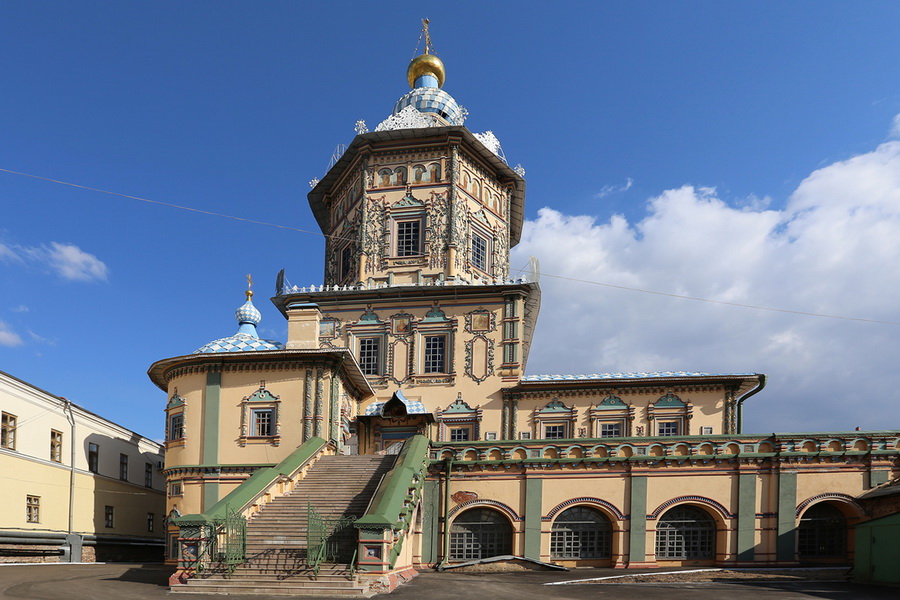
Peter and Paul Cathedral in Kazan, Russia is the city’s main religious attraction. An Orthodox church which offers a picturesque view of the Volga River region, it likewise provides a colorful glimpse into the nation’s intriguing past.
Kazan is the capital of the Russian Republic of Tatarstan. Commonly referred to as the "third capital of Russia", it is a cultural pearl within a vast country where varying cultures and religions have lived side-by-side for centuries. The city was once home to numerous mosques, until the conquest of Kazan in 1552 by the Russian Tsar Ivan the Terrible brought about their demolition. By order of the Tsar, Orthodox churches were built in their place, a decision which affected the birth of Orthodoxy in Kazan.
Peter and Paul Cathedral was built in 1726 in conjunction with two significant events, one which impacted the history of Russia and one which served as a milestone in the personal life of Peter I. At the end of May 1722, the emperor arrived in Kazan on his way to the shores of the Caspian Sea at the outset of the Russo-Persian War. While in town, he honored the rich local merchant Ivan Afanasievich Mikhlyaev by staying in his home to celebrate his 50th birthday. A 3-day feast was held for the king’s memorable milestone, and the merchant was so delighted that he decided to build a beautiful cathedral in honor of this significant event. The cathedral would replace the small local church being utilized at that time and was named after Peter and Paul, the apostles of Christ.
Construction of the church began in 1723 and lasted for 4 years. Shortly after construction commenced, the building suddenly collapsed. Upon hearing this news, the Tsar sent his own craftsmen and architects to successfully complete the Cathedral. A 49-meter-high bell tower was also built on the premises, and the merchant Ivan Afanasievich was later to be buried here.
Peter and Paul Cathedral was built in the Russian Baroque style. It is divided into upper and lower chapels and decorated with galleries. The facades of the cathedral are covered with brightly painted, high-quality ornamentation and unique decor. Ever since its completion, the cathedral’s striking beauty and pious aura have left a lasting impression on all those who enter. The cathedral was visited by every Russian emperor who succeeded Peter I, including Catherine II, and by countless famous Russians, including Alexander Pushkin.
Yet Peter and Paul Cathedral has seen its share of tragic events, including numerous fires and burglaries. The 18th century Cossack insurrectionist Emelyan Pugachev and the Soviet government did not spare the church from their respective campaigns of plunder and religious purging. During Soviet rule, the cathedral housed political institutions for many years before being converted into a planetarium. Mercifully, each time the church has managed to recover from the calamities inflicted upon it, and it has retained its former beauty to this day.
Today, Peter and Paul Cathedral attracts visitors not only with its cheerful décor and architecture but with several notable icons. These include the miraculous icon of the Smolensk Mother of God, the myrrh-infused icon of the Iberian Mother of God, the relics of Archbishop Ephraim, who was ordained in 1613 by Mikhail Romanov, and the relics of Arseniy Bishop of Jerusalem which were unearthed in 1995 during excavations of Spaso-Preobrazhensky Monastery on the territory of the Kazan Kremlin.
Worship services were finally recommenced in the cathedral in the 1990s. Peter and Paul Cathedral in Kazan is revered and loved not only by Orthodox Christians, but by those with an appreciation for beauty and a curiosity of the past.
Did you know? If you lived in Kazan during the life of the great opera singer Feodor Ivanovich Chaliapin, you could hear him singing during services at Peter and Paul Cathedral.
WHERE: 21 Musa Jalil street, Kazan.
WHEN: daily from 08:00 (07:00 on weekends) to 19:00.

